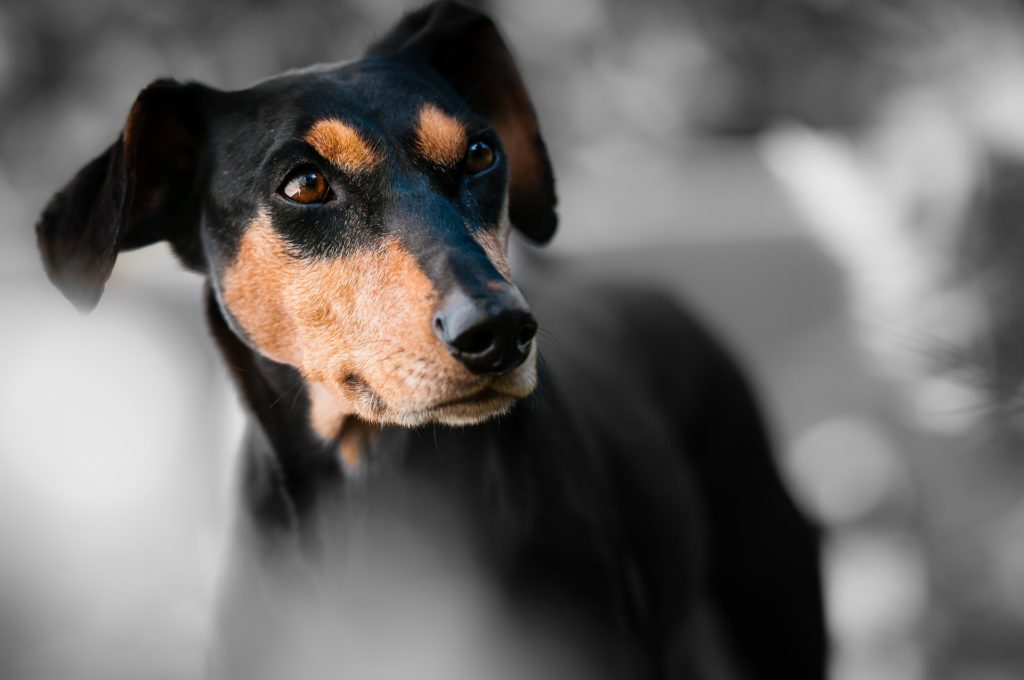There’s an interesting story behind these black and brown beauties. A man by the name of Karl Friedrich Louis Dobermann was the original developer of Dobermanns in the late 1800’s. Karl Dobermann was a tax collector, and he needed an athletic and imposing looking dog that would provide some security while he made his rounds.
Enter the Dobermann, or as they’re called in the US and Canada — Doberman Pinschers. Unfortunately, there were no proper records kept of the breed’s familial origin, but experts believe that Terriers, Shepherds and Rottweilers may have played a role in their lineage. So, how long do doberman live?
What is the average lifespan?
The average lifespan of a Doberman Pinscher is 10—13 years.
Before we get into the specifics of how long dobermans live, let’s get a clear picture of this dog breed‘s health first. The Doberman breed is very intelligent and highly trainable, which is why these dogs are so often used as working dogs or guard dogs — you may see them working for the police or military, as search and rescue members, or even as a guide dog. The combination of intelligence and athleticism means these pups aren’t usually couch potatoes, they stay active. Which is a good thing for the Doberman life expectancy and health complications. An active dog is a healthy dog.
What are the common health risks?
Unfortunately, every dog breed comes with a set of common health risks built into their DNA, and Dobies are no different. Below are some afflictions to be aware of as an owner that may affect the Doberman lifespan:

Bloat
Also referred to as torsion or gastric dilatation-volvulus in dogs. This is a painful condition characterized by a buildup of gas and fluid in the stomach. The stomach inflates, preventing the escape of gas/fluids, disrupting digestion, and limiting blood flow to the heart. If you own a Doberman puppy it’s recommended to familiarize yourself with the first signs of bloat by talking to your vet.
Wobbler Syndrome
Also referred to as cervical vertebral instability. The main characteristic of wobbler’s syndrome in dogs is a wobbly gait caused by malformations and abnormalities in the vertebrae. The wobbler disease is usually more common in bigger dogs. Surgery is an option that works. However, the success all depends on the exact condition of the dog’s spine.
Von Willebrand’s Disease
A blood clotting disease that affects dogs and humans. Von Willebrand’s disease in dogs is characterized by bleeding from the mouth, nose or in body fluids for no apparent reason. Unfortunately, there’s no cure, but there are several successful management methods. The main one is reducing rough playing, as it increases the chance of a bleeding event.
Chronic Active Hepatitis
Habitual and progressive inflammation of the liver eventually leading to cirrhosis. It’s not really possible to prevent it, as most Dobermans who suffer from this condition are already predisposed. Signs to look out for include lack of appetite, jaundice, bloated abdomen, and weight loss in your dog. It’s not curable, but proper treatment can allow dogs to live a long and happy life.
Color Dilution Alopecia
This is a condition of the skin characterized by permanent hair loss, leaving the Doberman puppy’s coat appearing faded and patchy. The hair follicles lose their ability to produce new healthy hair. It’s a genetic disease so prevention isn’t possible. It can be uncomfortable for dogs because of the scaliness and itchiness of the skin, but treatment and natural supplements like CBD for pets can relieve these symptoms.
Hyperthyroidism
Characterized by low hormone production, this condition is caused by an inflation of the thyroid gland. There are a multitude of symptoms to watch for including skin infections or problems, weight gain, canine lethargy,  behavioral changes etc. The good news is that it’s fairly easy to treat, especially in the early stages.
behavioral changes etc. The good news is that it’s fairly easy to treat, especially in the early stages.
Dilated cardiomyopathy
A form of heart disease. The main symptom is an enlarged, dysfunctional heart. Unfortunately, canine dilated cardiomyopathy in doberman pinschers puppies affects them more severely than other dogs. The life expectancy following this diagnosis is typically short, but if it’s caught early, treatment can slow the disease and make your dog’s life more comfortable.
Other common conditions include:
- Canine cherry eye
- Arachnoid cysts
- Canine cataracts
- Congenital portosystemic shunt
- Congenital deafness
- Nasal depigmentation
- Mucocutaneous hypopigmentation
How to extend the lifespan?
The toughest part about owning a dog is knowing that they won’t be around as long as we will. The best way to curb this reality is by having a strong relationship with your vet, being familiar with all of the common health risks for the Doberman breed, and giving them the right natural supplements.
While a lot of their common conditions are genetic and unpreventable, they are manageable. Despite their diagnosis, they can usually go on to live a happy and comfortable life.




